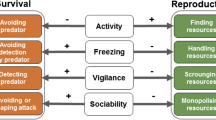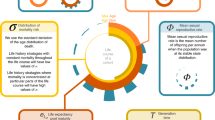Abstract
Comparative analyses have demonstrated the existence of a ”pace-of-life” (POL) continuum of life-history strategies, from fast-reproducing short-lived species to slow-reproducing long-lived species. This idea has been extended to the concept of a ”pace-of-life syndrome” (POLS), an axis of phenotypic covariation among individuals within species, concerning morphological, physiological, behavioral and life-history traits. Several life-history metrics can be used to place species in the fast-slow continuum; here, we asked whether individual variation in POL can also be studied using similar life-history measures. We therefore translated measures commonly used in demographic studies into individual-level estimates. We studied fecundity rate, generation time, lifespan, age at first reproduction, fecundity at first reproduction, and principal component scores integrating these different metrics. Using simulations, we show how demographic stochasticity and individual variation in resources affect the ability to predict an individual’s POL using these individual-level parameters. We found that their accuracy depends on how environmental stochasticity varies with the species’ position on the fast-slow continuum and with the amount of (co)variation in life-history traits caused by individual differences in resources. These results highlight the importance of studying the sources of life-history covariation to determine whether POL explains the covariation between morphological, physiological, and behavioral traits within species. Our simulations also show that quantifying not only among-individual but also among-population patterns of life-history covariation helps in interpreting demographic estimates in the study of POLSs within species.
Significance statement
It has been demonstrated that there is a continuum of life-history strategies, from fast-reproducing short-lived species to slow-reproducing long-lived species. This pattern of variation in the tempo of life-history strategies has been named the pace-of-life continuum. Recently, it has been suggested that within a population, variation in pace of life explains differences between individuals in their morphological, behavioral, and physiological traits. This paper provides guidelines on how to quantify the pace of life of individuals using demographic approaches that have been developed to study the pace of life of species.



Similar content being viewed by others
References
Araya-Ajoy YG, Dingemanse NJ (2014) Characterizing behavioural “characters”: an evolutionary framework. Proc R Soc B 281:20132645
Bauwens D, Diaz-Uriarte R (1997) Covariation of life-history traits in Lacertid lizards: a comparative study. Am Nat 149:91–111
Bielby J, Mace GM, Bininda-Emonds ORP, Cardillo M, Gittleman JL, Jones KE, Orme CD, Purvis A (2007) The fast-slow continuum in mammalian life history: an empirical reevaluation. Am Nat 169:748–757
Bjørkvoll E, Grøtan V, Aanes S, Sæther B-E, Engen S, Aanes R, Solow AE, Shaw ERG (2012) Stochastic population dynamics and life-history variation in marine fish species. Am Nat 180:372–387
Charlesworth B (1994) Evolution in age-structured populations. Cambridge University Press, Cambridge
Cody ML (1966) A general theory of clutch size. Evolution 20:174–184
Dammhahn M, Dingemanse NJ, Niemelä PT, Réale D (2018) Pace-of life syndromes: a framework for the adaptive integration of behaviour, physiology and life-history. Behav Ecol Sociobiol, topical collection on Pace-of-life syndrome
Descamps S, Gaillard J-M, Hamel S, Yoccoz NG (2016) When relative allocation depends on total resource acquisition: implications fort the analysis of trade-offs. J Evol Biol 29:1860–1866
Dingemanse NJ, Dochtermann N (2013) Quantifying individual variation in behaviour: mixed-effect modelling approaches. J Anim Ecol 82:39–54
Dingemanse NJ, Dochtermann N, Wright J (2010) A method for exploring the structure of behavioural syndromes to allow formal comparison within and between data sets. Anim Behav 79:439–450
Ferrari SLP, Cribari-Neto F (2004) Beta regression for modelling rates and proportions. J Appl Stat 31:799–815
Fry JD (1993) The “general vigor” problem: can antagonistic pleiotropy be detected when genetic covariances are positive? Evolution 47:327–333
Gaillard J-M, Lemantre JF, Berge V, Bonenfant C, Devillard S, Douhard M, Gamelon M, Plard F, Lebreton JD (2016) Life histories, axes of variation. In: Kliman RM (ed) Encyclopedia of evolutionary biology. Academic Press, Oxford, pp 312–323
Gaillard J-M, Pontier D, Allainé D, Lebreton JD, Trouvilliez J, Clobert J (1989) An analysis of demographic tactics in birds and mammals. Oikos 56:59–76
Gaillard J-M, Yoccoz NG, Lebreton J-D, Bonenfant C, Devillard S, Loison A, Pontier D, Allaine D (2005) Generation time: a reliable metric to measure life-history variation among mammalian populations. Am Nat 166:119–123
Goodwin NB, Grant A, Perry AL, Dulvy NK, Reynolds JD (2006) Life history correlates of density-dependent recruitment in marine fishes. Can J Fish Aquat Sci 63:494–509
Grace JB, Anderson TM, Olff H, Scheiner SM (2010) On the specification of structural equation models for ecological systems. Ecol Monogr 80:67–87
Hamel S, Gaillard J-M, Yoccoz NG, Loison A, Bonenfant C, Descamps C (2010) Fitness costs of reproduction depend on life speed: empirical evidence from mammalian populations. Ecol Lett 13:915–935
Houle D (1991) Genetic covariance of fitness correlates: what genetic correlations are made of and why it matters. Evolution 45:630–648
Jones OR, Gaillard J-M, Tuljapurkar S et al (2008) Senescence rates are determined by ranking on the fast-slow life-history continuum. Ecol Lett 11:664–673
Kendall B, Wittmann M, Neubert AE, De Angelis ED (2010) A stochastic model for annual reproductive success. Am Nat 175:461–468
Lande R (1982) A quantitative genetic theory of life history evolution. Ecology 63:607–615
Mac Nulty DR, Smith DW, Vucetich JA, Mech LD, Stahler DR, Packer C (2009) Predatory senescence in ageing wolves. Ecol Lett 12:1347–1356
Mathot K, Frankenhuis W (2018) Models of pace-of-life syndromes (POLS): a systematic review. Behav Ecol Sociobiol, topical collection on Pace-of-life syndrome
Montiglio P-O, Dammhahn M, Dubuc-Messier G, Réale D (2018) The pace-of-life syndrome revisited: the role of ecological conditions and natural history on the slow-fast continuum. Behav Ecol Sociobiol, topical collection on Pace-of-life syndrome
Oli MK (2004) The fast–slow continuum and mammalian life-history patterns: an empirical evaluation. Basic Appl Ecol 5:449–463
Oli MK, Dobson FS (2003) The relative importance of life history variables to population growth rate in mammals: Cole’s prediction revisited. Am Nat 161:422–440
Oli MK, Dobson FS, Pfiste AECA, Losos EJB (2005) Generation time, elasticity patterns, and mammalian life histories: a reply to Gaillard et al. Am Nat 166:124–128
Promislow DEL, Harvey PH (1990) Living fast and dying young: a comparative analysis of life-history variation among mammals. J Zool 220:417–437
Réale D, Garant D, Humphrie MM, Bergeron P, Careau V, Montiglio P-O (2010) Personality and the emergence of the pace-of-life syndrome concept at the population level. Philos T Roy Soc B 365:4051–4063
Reznick D (1985) Costs of reproduction: an evaluation of the empirical evidence. Oikos 44:257–267
Reznick D, Nunney L, Tessier A (2000) Big houses, big cars, superfleas and the costs of reproduction. Trends Ecol Evol 15:421–425
Roff DA (1993) Evolution of life histories: theory and analysis. Springer, New York
Saether B-E (1988) Pattern of covariation between life-history traits of European birds. Nature 331:616–617
Saether B-E, Bakke O (2000) Avian life history variation and contribution of demographic traits to the population growth rate. Ecology 81:642–653
Saether B-E, Engen S, Møller AP et al (2004) Life-history variation predicts the effects of demographic stochasticity on avian population dynamics. Am Nat 164:793–802
Saether B-E, Lande R, Engen S et al (2005) Generation time and temporal scaling of bird population dynamics. Nature 436:99–102
Salguero-Gómez R, Jones OR, Jongejans E, Blomberg SP, Hodgson DJ, Mbeau-Ache C, Zuidema PA, de Kroon H, Buckley YM (2016) Fast–slow continuum and reproductive strategies structure plant life-history variation worldwide. P Natl Acad Sci USA 113:230–235
Santostefano F, Wilson AJ, Niemelä P, Dingemanse NJ (2017) Behavioral mediators of genetic life history trade-offs: a test of the pace-of-life syndrome hypothesis. Proc R Soc B 284:1864
Stearns SC (1983) The influence of size and phylogeny on patterns of covariation among life-history traits in mammals. Oikos 41:173–187
Stearns SC (1989) Trade-offs in life-history evolution. Funct Ecol 3:259–268
Stearns SC (1992) The evolution of life histories. Oxford University Press, Oxford
van Noordwijk AJ, de Jong G (1986) Acquisition and allocation of resources: their influence on variation in life history tactics. Am Nat 128:137–142
Tarka M, Guenther A, Niemelä, PT, Nakagawa S, Noble DWA (2018) Sex differences in life-history, behavior and physiology along a slow-fast continuum: a meta-analysis. Behav Ecol Sociobiol, topical collection on Pace-of-life syndrome
Wilson AJ, Nussey DH (2009) What is individual quality? An evolutionary perspective. Trends Ecol Evol 25:207–214
Wilson AJ, Réale D, Clements MN, Morrissey MB, Postma E, Walling CA, Kruuk LEB, Nussey DH (2010) An ecologist’s guide to the animal model. J Anim Ecol 79:13–26
Williams GC (1966) Natural selection, the costs of reproduction, and a refinement of Lack’s principle. Am Nat 100:687–690
Acknowledgements
We are grateful to the sponsors, organizers, and participants of the VW-funded workshops ‘Towards a general theory of POLS,” Hannover 2015-6, which inspired this journal topical collection and provided feedback during discussions of earlier versions of the ideas presented here. We also thank Jean-Michel Gaillard, Melanie Dammhahn, Denis Réale, and one anonymous reviewer for the insightful comments during the reviewing process. This work was supported by the European Research Council (ERC-2010-AdG 268,562) and the Research Council of Norway (SFF-III 223257/F50).
Author information
Authors and Affiliations
Corresponding author
Ethics declarations
Conflict of interest
The authors declare that they have no conflict of interest.
Additional information
Communicated by M. Dammhahn
This article is a contribution to the Topical Collection Pace-of-life syndromes: a framework for the adaptive integration of behaviour, physiology and life-history – Guest Editors: Melanie Dammhahn, Niels J. Dingemanse, Petri T. Niemelä, Denis Réale.
Rights and permissions
About this article
Cite this article
Araya-Ajoy, Y.G., Bolstad, G.H., Brommer, J. et al. Demographic measures of an individual’s “pace of life”: fecundity rate, lifespan, generation time, or a composite variable?. Behav Ecol Sociobiol 72, 75 (2018). https://doi.org/10.1007/s00265-018-2477-7
Received:
Revised:
Accepted:
Published:
DOI: https://doi.org/10.1007/s00265-018-2477-7




